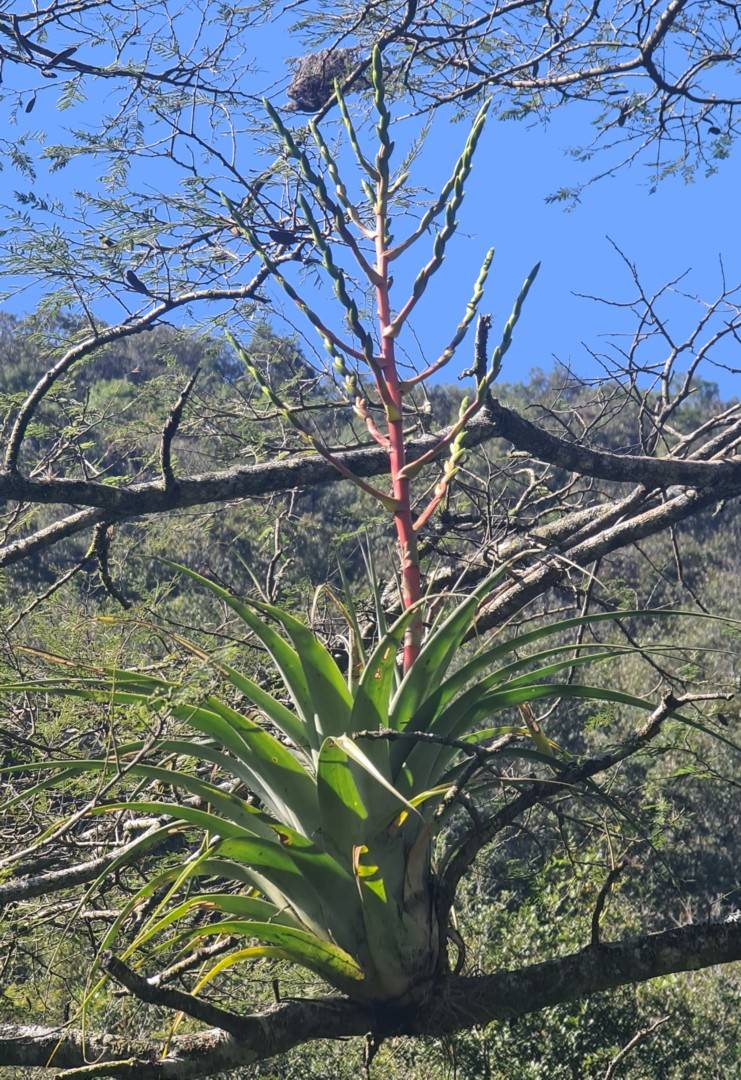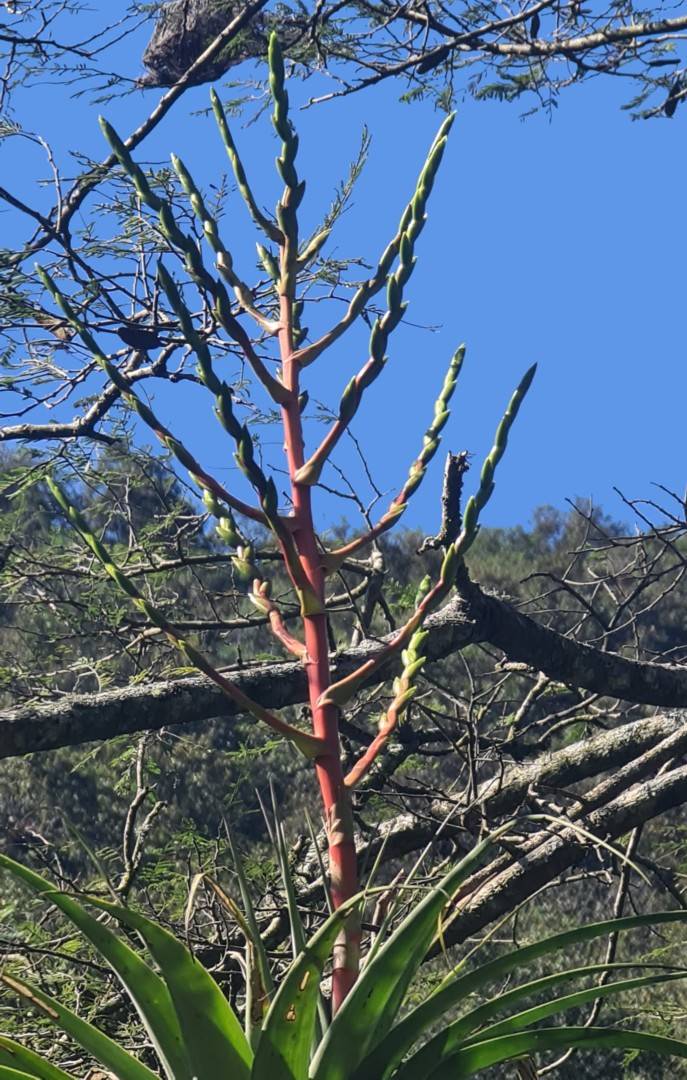


A Tillandsia limbata Schtdl., cui versimiliter affinis, rosula e minus foliis perrigidis coriaceisque, nervatis, pallide viridibus composita, vaginis foliorum inconspicuis, laminis foliorum late triangularibus, inflorescentia toto robustiora, rhachide per robusta internodiis minoribus, floribus majoribus rhachidem minus attingentibus, bracteis florigeris latioribus, suborbicularibus, sepalis multo latioribus (15mm versus 8-9mm), petalis erectis absque sinuum et stigmate laminis convolutis differt; a T. makoyana foliis viridibus, brevioribus latioribusque, rachide minus geniculata, internodiis sepalibus brevioribus, floribus subsessilibus, bracteis florigeris non distinte nervatis, sepalis minoribus subtus non brunneopunctulatis, et petalis minoribus albis differt.
Typus: Mexico, Estado Chiapas, km 130 inter urbes San Christobal de las Casas et Comitan, 2090 m s. m, 27. 11. 2001, leg. R. Ehlers EM 011302 (Mexu, holo); km 167 inter urbes San Christobal de las Casas et Comitan, 1750 m, 11. 2. 2003, leg. R. Ehlers EM031002 (WU, para Estado Chiapas, in via Copainala ad Coapila, 1500 m s. m., 9. 2. 2003, leg. R. Ehlers EM 030805 (WU, para).
Plant stemless, 30 - 40cm high, flowering to 90cm, a more or less spreading rosette
Leaves many, 20 - 40cm long, light green, rigid, densely and finely appressed-cinereous-lepidote throughout, especially underneath, appearing green.
Sheaths elliptic-ovate, 10 - 20cm long, 7 - 10cm wide, inconspicuous, adaxially castaneous, abaxially concolorous with the blade,
Blades triangular, caudate-attenuate, 20 to 30cm long, 5 - 7cm wide above the sheat, abaxially nerved.
Scape erect or little spreading, very stout, from slightly shorter than to exceeding the leaves, bright rose.
Scape-bracts erect, the lower ones lanceolate, caudate, the sheats ca. 2cm long, imbricate, internodes 2 - 3cm, adpressed to the scape, leaving the rose, glabrous scape visible, the upper ones ovate, acute
Inflorescence pyramidal, laxely bipinnate, 20 - 40cm long; 20 - 30cm wide, surpassing the rosette, internodes between the branches 1 - 2cm composed of 5 - 15 branches.
Primary bracts like the upper scape-bracts, 1 - 2cm long, enfolding the lower half or third of the sterile base of the axillary branch.
Branches 10 - 25cm long, spreading 25 - 45degree, composed of 7 - 20 laxly distichous, sessile flowers,
Rhachis geniculate, stout, flattened next the flowers, bright rose, glabrous, visible, internodes about 1 - 1.2cm, about half as long as the sepals
Flowers erect and closely appressed to the rhachis, 1/2 - 1/3 contiguous with it.
Floral bracts 5mm shorter than the sepals to 1.8 - 2cm long, 1.6 - 1.8cm wide, orbicular-ovate, nearly obtuse, shorter than the sepals, enfolding the base of the sepals and 3/4 of the rhachis, green, glabrous, coriaceous with thin margins, adaxially slightly nerved, ecarinate;
Sepals 20- 25mm long, 15mm wide, broadly obovate, obtuse, nearly free, coriaceous, even, green, glabrous, adaxially slightly nerved.
Petals tubular-erect, 4cm long, 7 - 8mm wide, 6mm at the base, throat slightly open, the obtuse tips slightly spreading, greenish - white.
Stamens and pistil excerted, filaments to 5cm long in two sets of unequal length, thin, round -oval in cross section and equal in diameter for the entire length, whitish green, concolorous with the petals,
anthers 3 - 4mm long, 1mm wide, versatile fixed 1/3 from the base, style 4cm long, white, stigma 2 x 2mm, lobes erect, little spreading, green.
Ovarium 6mm high, 3mm at base.
The plant is monocarpic.
The plant seems to be related to T. limbata Schlechtendal 1845 and to T. makoyana Baker.
It differs from Tillandsia limbata Schlechtendal 1845 by the following characters:
Rosette of fewer, very rigid and coriaceous thick leaves, nerved and light green, the sheaths inconspicuous, the blade broadly not narrowly triangular. Inflorescence stouter in all parts, rhachis very stout, flowers much bigger, erect with no sinus, internodes smaller, contiguous with the rhachis for 1/2 - 1/3 not 2/3, floral bracts wider, nearly orbicular, sepals much wider (15mm not only 8-9), petals bigger erect with no sinus, throat less open. The plant is monocarpic not polycarpic.
From Tillandsia makoyana Baker it differs :
Plant green not grey, leaves shorter but wider, rhachis of the spikes less geniculate, internodes of the flowers not equaling the sepals but smaller, nearly no pedicels, floral bracts not prominently nerved, sepals smaller, not brown-punctulate inside, petals smaller, white with slightly open throat, not violet with closed throat.
Type: Mexico, Estado Chiapas, km 130 between San Christobal de las Casas and Comitan, 2090m s. m, 27. 11. 2001, leg. R. Ehlers EM 011302 (Mexu, holo); km 167 between San Christobal de las Casas and Comitan, 1750m, 11. 2. 2003, leg. R. Ehlers EM031002 (WU, para Estado Chiapas, road Copainala to Coapila, 1500m s. m., 9. 2. 2003, leg. R. Ehlers EM 030805 (WU, para).
Geographical distribution:
This Tillandsia is widely spread through the highland of Chiapas but it always grows in the higher elevations.
Estado Chiapas, Lagunas Montebello, April 1982, photo K. Ehlers; Estado Chiapas, Lagunas Montebello, photo. J. Brinkmann 8/28, 1993, Las Margaritas photo R. Ehlers s. n. Nov. 2001.
Robert and Victoria Guess found it around Aguacatenango, Amatenango, Teopisca, Lagos de Montebello and Las Margaritas. They also have seen it in the Central Depression, but not in the same numbers. And they said that hundreds of these plants come into San Cristóbal at Christmas time.
The plant is monocarpic.
History:
When I travelled with Klaus more than 20 years ago in Chiapas we already took photos of this plant. But as it was so big and we thought it is T. dasyliriifolia. So we never collected any plant for our collection at home. Also from other friends like the Brinkmann's from Berlin we got photos.
But in November 2001 I travelled with Lydia and Gerhard Köhres through Chiapas and as I was interested in the meantime to get as much knowledge as possible about the T. limbata - T. dasyliriifolia family I took 2 big plants to Germany. I became very excited when the plant was flowering because it did not fit neither of the plants I thought it is related to. On my trip with Jürgen and Uli Lautner and Manfred Kretz in February 2003 I recollected the Tillandsia. In our discussions Robert and Victoria Guess thought that this plant is T. dasyliriifolia. But I found too many different characters also to this species and as well to T. limbata and T. makoyana, so I described it and named it Tillandsia comitanensis.
The name refers to Comitan, the place where we found the plant for the first time.